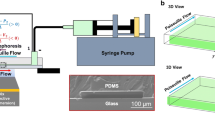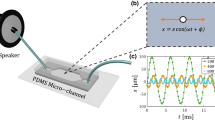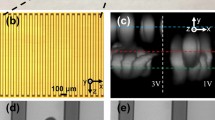Abstract
Transient displacements of optically trapped particles in [NaCl] \(=\) 0.1 mM solutions produced by electroosmotic and electrophoretic forces at electric field start-up were profiled wall-to-wall through \(50\,\upmu \hbox {m}\) in a commercial microfluidic channel with a spatial resolution of \(1\,\upmu \hbox {m}\) and temporal resolution of 200 kHz. Data were inverted to compute the force on the particles and fitted to a first-principles finite element methods model to compute the flow profile, and zeta potential of the walls and particles. This analysis suggested that (1) electroosmotic flow in the channel was accompanied by a pressure gradient, producing backflow, and which was attributed to bubbles within the channel and that (2) while the zeta potential of the wall was broadly consistent with that expected, the zeta potentials across the nine particles examined was higher than might be expected, which were attributed to differences in surface conditions of the particular particles used.










Similar content being viewed by others
Data Availability Statement
The datasets generated during and/or analysed during the current study are available from the corresponding author on reasonable request.
References
Aris R (1956) On the dispersion of a solute in a fluid flowing through a tube. Proc R Soc Lond A 235:67–77
Berg-Sørensen K, Flyvbjerg H (2014) Power spectrum analysis for optical tweezers. Rev Sci Instrum 75:594–612
Chang CC, Wang C-Y (2008) Starting electroosmotic flow in an annulus and in a rectangular channel. Electrophoresis 29:2970–2979
Folkersma R, van Diemen AJG, Stein HN (1998) Electrophoretic properties of polystyrene spheres. Langmuir 14:5973–5976
Hansen PM, Dreyer JK, Ferkinghoff-Berg J, Oddershede L (2005) Novel optical and statistical methods reveal colloid-wall interactions inconsistent with DLVO and Lifshitz theories. J Colloid Interface Sci 287:561–571
Hunter RJ (2001) Foundations of colloid science. Oxford University Press Inc., New York
Jones PH, Marago OM, Volpe G (2015) Optical tweezers: principles and applications. Cambridge University Press, Cambridge
Kahl V, Gansen A, Galneder R, Rädler JO (2009) Microelectrophoresis in a laser trap: a platform for measuring electrokinetic interactions and flow properties within microstructures. Rev Sci Instrum 80:073704
Keh HJ, Tseng HC (2001) Transient electrokinetic flow in fine capillaries. J Colloid Interface Sci 242:450–459
Kirby BJ (2010) Micro- and nanoscale fluid mechanics: transport in microfluidic devices. Cambridge University Press, Cambridge
Marcos Yang C, Wong TN, Ooi KT (2004) Dynamic aspects of electroosmotic flow in rectangular microchannels. Int J Eng Sci 42:1459–1491
Miller A, Villegas A, Diez FJ (2015) Characterization of the startup transient electrokinetic flow in rectangular channels of arbitrary dimensions, zeta potential distribution, and time-varying pressure gradient. Electrophoresis 36:692–702
Nge PN, Rogers CI, Woolley AT (2013) Advances in microfluid materials, functions, integration, and applications. Chem Rev 113:2550–2583
Raudsepp A, Griffiths M, Sutherland-Smith AJ, Williams MAK (2015) Developing a video tracking method to study interactions between close pairs of optically trapped particles in three dimensions. Appl Opt 54:9518–9527
Raudsepp A, Kent LM, Hall SB, Williams MAK (2018) Overstretching partially alkyne functionalized dsDNA using near infrared optical tweezers. Biochem Biophys Res Commun 496:975–980
Semenov I, Otto O, Stober G, Papadopoulos P, Keyser UF, Kremer F (2009) Single colloid electrophoresis. J Colloid Interface Sci 337:260–264
Smith SW (1997) The scientist and engineer’s guide to digital signal processing. California Technical Publishing, San Diego
Sureda M, Miller A, Diez FJ (2012) In situ particle zeta potential evaluation in electroosmotic flows from time-resolved microPIV measurements. Electrophoresis 33:2759–2768
Tang G, Yan D, Yang C, Gong H, Chai JC, Lam YC (2006) Assessment of joule heating and its effects on electroosmotic flow and electrophoretic transport of solutes in microfluidic channels. Electrophoresis 27:628–639
Tuin G, Sender JHJE, Stein HN (1995) Electrophoretic properties of monodisperse polystyrene particles. J Colloid Interface Sci 179:522–531
van Heiningen JA, Mohammadi A, Hill RJ (2010) Dynamic electrical response of colloidal micro-spheres in compliant micro-channels from optical tweezers velocimetry. Lab Chip 10:1907–1921
Yan D, Nguyen NT, Yang C, Huang X (2006) Visualizing the transient electroosmotic flow and measuring the zeta potential of microchannels with a micro-PIV technique. J Chem Phys 124:021103
Zhao C, Zhang W, Yang C (2017) Dynamic electroosmotic flows of power-law fluids in rectangular microchannels. Micromachines 8:34
Author information
Authors and Affiliations
Corresponding author
Additional information
Publisher's Note
Springer Nature remains neutral with regard to jurisdictional claims in published maps and institutional affiliations.
Rights and permissions
About this article
Cite this article
Raudsepp, A., Hall, S.B. & Williams, M.A.K. Probing start-up electroosmotic forces and flows in a microfluidic channel using laser tweezer force spectroscopy. Microfluid Nanofluid 24, 87 (2020). https://doi.org/10.1007/s10404-020-02389-5
Received:
Accepted:
Published:
DOI: https://doi.org/10.1007/s10404-020-02389-5




